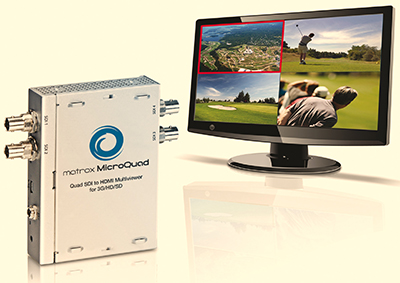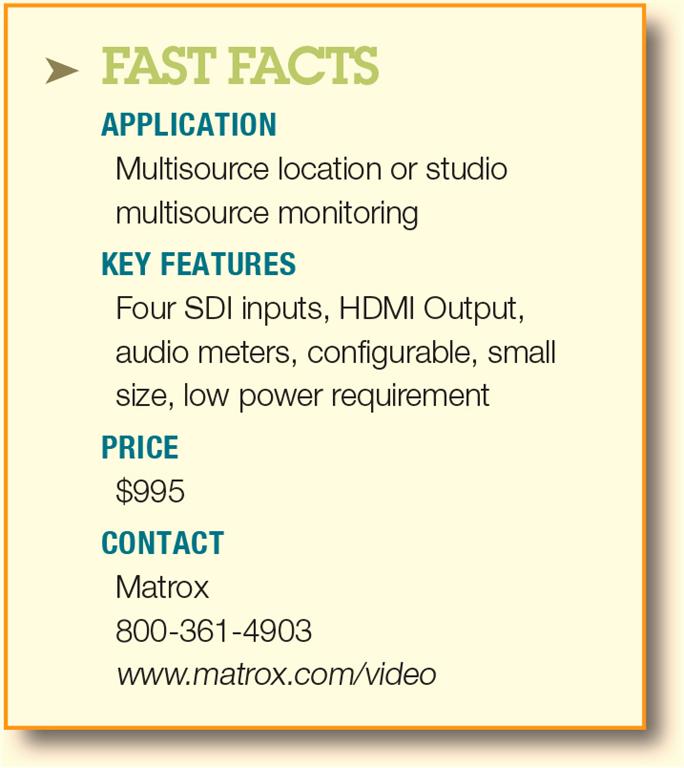Matrox’s MicroQuad Multiviewer

The Matrox MicroQuad Multiviewer
Small is good!
In so many situations, we as videographers have so much equipment to move about in order to do our jobs. When a product appears that makes life on the shoot easier and doesn’t require another large bag or trip to the truck to carry, this makes life and work that much easier. Matrox’s new MicroQuad is a little box that solves several location monitoring problems handily, providing the capability to view as many as four HD-SDI sources through a connection to a single HDMI monitor.
FEATURES
The MicroQuad is contained in a 5 x 4.5 x 1-inch steel box and powered by the included wall wart-style multiple voltage AC-to-DC adaptor (with multiple plugs for use in different countries). The power cable is designed to lock into the MicroQuad for a secure connection. The unit weighs only about half a pound and has four BNC SDI inputs (terminated), one “type A” HDMI output, a bank of eight DIP switches, status LEDs at each input, and three buttons for local control.
Input formats include 1080 and 720 resolutions— interlaced, progressive, or PsF— at all the standard frame rates (which are auto-sensed on input).
The MicroQuad, which is SMPTE 259M/292M/424M-compliant, does not perform standards conversions, so all inputs must be the same format—the HDMI output format is the same as the SDI input format. YUV SDI signals are supported at 4:2:2 sampling in 8- or 10-bit quality. As many as 16 embedded audio channels are supported at the SDI input; and up to eight embedded audio channels are available at the HDMI output.
Three buttons on the side—marked with a plus, a minus, and a circular sign—allow for cycling through inputs, selecting an input for full screen viewing, and returning to the quadrant presentation. DIP switches provide local, on-box control of certain parameters, including button lock, show/hide source labels, show/hide selection box (this designates which input will appear when switched to quad view), show/hide VU meters, lock audio to source 1 (no matter which source is chosen for display), and PsF (or not) video inputs.
All the on-box controls are duplicated in a software control panel, available only to Windows users (Windows 7 (32- or 64-bit) with Service Pack 1, or Windows XP (32-bit) with Service Pack 3) with a USB port. This means that the user can manipulate the box from a distance and in a much more facile manner than by flipping DIP switches and pressing buttons on the box itself.
In addition, users of the software can apply custom 10-character labels to each input, select which embedded audio channel pair is monitored, with all embedded audio sent to VU meters and the HDMI output device. The Windows user can also use keyboard shortcuts to switch between sources and quad view.
The HDMI monitor display is simple and effective to use. As its name implies, the quad view provides four equal quadrants of the screen, each with a source label and two channels of VU metering, and there’s a red box around the input selected to go full screen. The VU meters take the form of vertical bars, which are color calibrated to the dBFS scale: gray indicates no audio present, green shows between −60 and −18, yellow shows between −9 and −17, and red between 0 and −8.
IN USE
I put the MicroQuad into service on a four-camera music video shoot where I was working as an operator. The alternative and previous setup had the director swapping out SDI cables on a 24-inch monitor every time he wanted to check a different camera (a workable but clumsy system). When the cheering and round of thanks for bringing the Micro- Quad died down, we found hookup to be a snap. We only had to rig a short HDMI cable from the MicroQuad to the monitor, slightly reroute the dangling SDI cables (which had been hot swapped) and apply power. (DIP switches and buttons can be used when the unit is powered.) There wasn’t a Windows computer in sight, so we couldn’t do anything fancy about labeling, but fortunately, the director didn’t need such labels. We just placed the MicroQuad next to him and he used the buttons to switch between full view sources and quad views as needed. The box really didn’t take up any space or require any serious instructions for use. And it could be operated in the near dark—factors which were greatly appreciated by all concerned.
We (director, DP, producer, camera operators, grips) found the display very easy to look at and very helpful. There was not too much information presented in each quadrant of the display, just the source label and two audio VU meter bars. The quadrant views were plenty sharp and clear enough to check for accurate focus, even lighting, matched colors and white balance, and at least the presence of audio. (There was a separate multichannel audio recording being made, so we just needed clear audio on each camera for synchronizing purposes.)
We found that there was really no need for any more on-screen information anyway; it would only have to be turned off, which would just add to setup time. The fact that the MicroQuad coincidentally functions as an SDI to HDMI converter and can pass the signal through cleanly at up to 10-bit precision without any overlays (labels or audio meters) is a bonus.
SUMMARY

The capability for simultaneous, multisource viewing has long been the province of expensive, rackmounted boxes or the built-in function of expensive multiple input switchers. The Matrox MicroQuad provides multiviewer capabilities for location or studio shoots in a small, lightweight, easy to setup and use, and affordable package. It would be nice to find Mac support available for the software control panel, but that was only a slight ease of use issue and not terribly vital. The design of the MicroQuad, both physically and operationally, is lean, mean, and very clean. If you work in an SDI, multicamera environment, and monitoring is important in your workflow, Matrox’s MicroQuad deserves a serious evaluative look.
Michael Hanish operates Free Lunch, a video/audio/multimedia production house near Guilford, Vt. He may be contacted atmichael@freelunchmedia.com.
Get the TV Tech Newsletter
The professional video industry's #1 source for news, trends and product and tech information. Sign up below.
